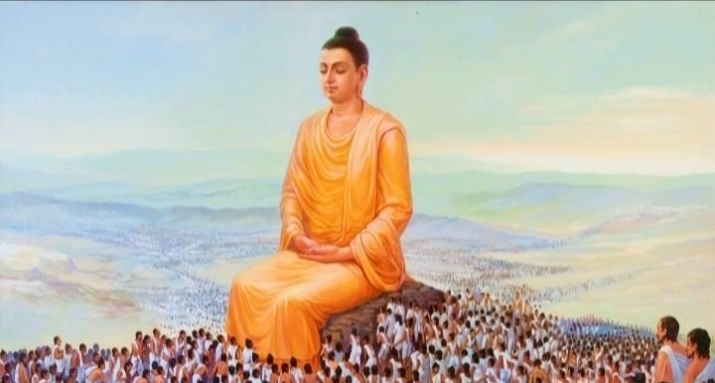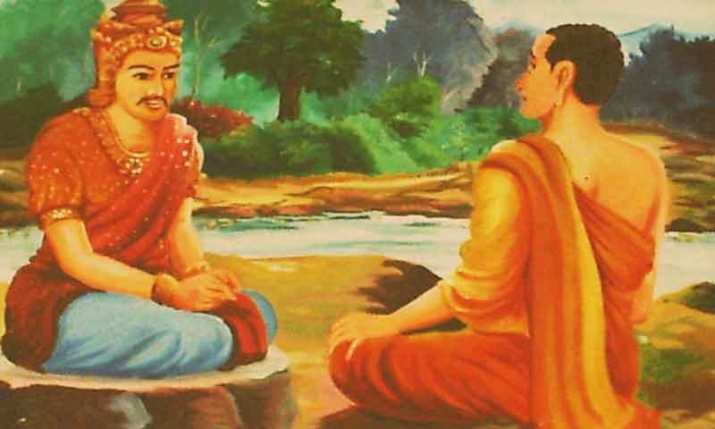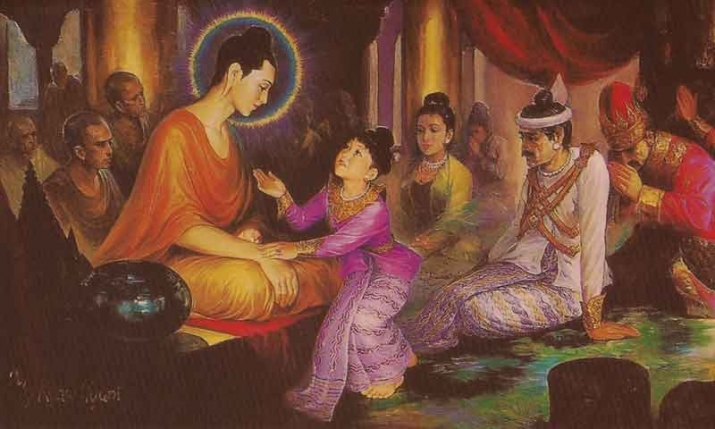FEATURES|THEMES|Festivals and Teachings
Falguni Purnima: Celebrating Family Reunions and the Buddha’s Life
 From worldamity.wordpress.com
From worldamity.wordpress.comIn South and Southeast Asia, important Buddhist festivals are often celebrated on the day of the full moon (Purnima). For instance, the Buddha’s birth, enlightenment, first sermon, and Mahaparinirvana are celebrated during the full moon day in the months of either April or May in the Gregorian calendar. This is called Buddha Purnima (or many other names, such as Vesak or Buddha Jayanti) and is the most prominent Buddhist festival in the world. But there is another Buddhist festival called Faguni Purnima, which falls on the day of the full moon in the month of Falgun, which this year corresponded with 13 March.
Falgun (or Phalgun) is the 11th month in the Bengali and Indian calendars and marks the arrival of spring. The first day of Falgun is known as “Bosonto Utsob” (Spring Festival) and usually falls on 13 February. This festival is celebrated in Bangladesh, West Bengal, Assam, and many parts of India. The full moon falling on this month is considered a sacred day for both Buddhist and Hindu communities. While the Hindus famously call the day Holi, also known as the Festival of Colors or the Festival of Love, Buddhists celebrate is as the day of reunion between the Buddha and his relatives.
After his enlightenment, the Buddha went to his hometown of Kapilavastu where he met his father, King Suddhodhana, his stepmother, Queen Mahapajapati, and other family members whom the Buddha had not seen since he renounced his life in the palace years earlier. The story goes that while the Buddha was staying with his fellow monks at Venuvana or Bamboo Park, which had been gifted by King Bimbisara (in modern Rajgir in Nalanda district, Bihar), his father, hearing of his son's enlightenment, wished to see him.
The king sent one of his ministers to invite the Buddha and his monastic community to the palace, but on hearing the Buddha’s sermon they forgot their mission, and all of them joined the monastic order. More messengers were sent out by Suddhodhana, but each of them joined the monastic order and did not return to Kapilavastu. Suddhodhana's desire to see his son grew more intense, and finally he sent Kaludayi, a childhood friend of the Buddha. Even Kaludayi was unable to resist joining the sangha, although he was able to convince the Buddha to visit Kapilavastu.
 From hinduwebsite.com
From hinduwebsite.comAnother story goes that while the Buddha was travelling to Kapilavastu with a large retinue of monks, the Sakyas, the ethnic group of which the Buddha was a member, prepared a park called Nigrodharama outside Kapilavastu. As the Sakyas were proud and arrogant, many of them did not bow down in front of the Buddha while welcoming him because they thought of the Buddha as of the same age. The Buddha then performed various miracles to convince them of his worthiness of reverence, although miracle-making was later rarely permitted by the Buddha. Seeing the miracles, the Shakyas repented of their ignorance and went on their knees. It is said that the Buddha then preached the Vessantara Jataka, one of the most popular stories about the Buddha’s past lives. It is about a compassionate prince, Vessantara, who gives away not only his possessions but also his children, thereby displaying the virtue of perfect charity.
The following morning the Buddha went for the alms with his disciples. As they walked through the streets of the city, observers went to Suddhodhana and reported how the Buddha was begging for food. Upon hearing the news that his son, a former prince, was begging from his own people, the king hurried to the Buddha and said that he humiliated the royal family by acting like a beggar. The Buddha explained to his father that taking alms was practiced by all the previous Buddhas, and one of his core roles. The king then invited the Buddha and his disciples to accept food in the palace.
After eating and preaching to his family at the request of his father, the Buddha and two of his senior disciples went to the living quarters of Yashodhara, the former wife of the Buddha, to see her. The Buddha met with her and his son, Prince Rahula, who was seven years old at the time. When the Buddha was departing, Yashodhara sent her son to her former husband to demand his inheritance. The Buddha responded by ordaining him as a novice monk.
Rahula’s ordination was the final straw for the king, who already had lost his son, now the Buddha, as an heir. Losing his grandson was not only personally harrowing, but potentially disastrous for the already disrupted royal succession. We do not know whether the Buddha might have indeed felt sympathy for his father’s distress, for he agreed to promise the king that he and his disciples would no longer ordain children without the permission of their parents. This rule is still followed today.
 The Buddha in Kapilavastu with Rahula. From hinduwebsite.com
The Buddha in Kapilavastu with Rahula. From hinduwebsite.comIn Bangladesh, Falguni Purnima heralds a time for renewed spiritual activity in some sacred Buddhist locales. The day is celebrated by holding fairs at different villages of Chittagong district. Offering alms to the monks are considered meritorious. Uposatha rules are recited (these are Buddhist observances dating back to the time of the Buddha, during which members of the sangha evaluate their discipline as laid down in the Patimokka, the code of law governing conduct within the sangha). Traditionally, a minimum of four monastics is required to recite the Patimokkha but when fewer monastics are present, the Vinaya prescribes alternative activities. The most senior monk of the group leads the ceremony, following a ritual for mental purification.
Some of the most famous fairs are called: Shakyamuni Mela, Achariyar Mela, Dhatu Mela, Bodhi Mela, and Dhatumela Falguni Astami. Several years ago in Bangladesh, I participated in Shakyamuni Mela at the Shakyamuni Temple in the province of Dhemsa, Chittagong. The fair was held in the temple courtyard, and thousands of lay followers came to the fair dressed in white to pay their respects to the Buddha. Seated before the monastic congregation on mats spread around the ground, the lay practitioners pledged to observe the five precepts.
The ceremony was marked by a long period of chanting, paying homage to the Buddha, the Dhamma, and the Sangha, followed by offerings of food, flowers, incense, and lamps. The participants shared the accumulated merit with friends, family, and all sentient beings. The session concluded shortly before noon with alms for the sangha. Many of them chose to remain at the temple afterwards to attend a Dhamma talk, read books, or meditate.
Today, Falguni Purnima is a chance to not only perform meritorious acts, but also to experience the joyful, sometimes bittersweet spirit of family reunions, just like the Buddha did with his father and former wife.














